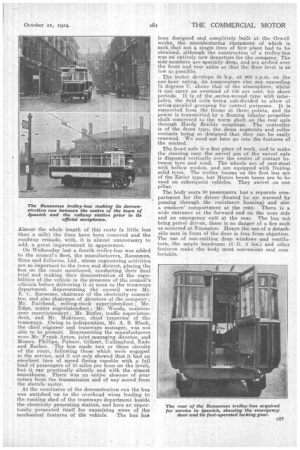IPSWICH'S FOURTH TROLLEY-BUS.
Page 10

Page 11

If you've noticed an error in this article please click here to report it so we can fix it.
The Conversion of the Town's Passenger System from Trams to Trolley-bus provides an Incentive to a Prominent Local Manufacturer.
IN THE spring of the year the tramways committee of the Ipswich Borough Council took the first step towards the abolition of the trams and tramway track, which had ceased te be profitable under post-war
conditions and with heavy permanent-way costs and estimates, and embarked upon the conversion of the system to one which should replace the tramcars by trolley-buses. The total length of the streets traversed by the tramway system is nearly 11 miles, and nearly 600,000 passengers are carried per annum. The last published figures show that the total annual receipts were about 243,300, and that, after meeting interest, special charges, working expenses and loan repayment charges, there was a deficit of nearly 23,200.
The streets of Ipswich are particularly narrow, so that at very few placos may another vehicle be accommodated where two trams meet. In the shopping centres the difficulty thus presented is acute, for it is not possible for any vehicle to wait at a shop for more than a few moments. Owing to. wartime and post-war difficulties, maintenance and renewal charges have in recent years reached a high level, and, as the service is sufficiently frequent to justify the employment of trolley-buies, the momentous decision was made to put the trolley-bus to the test on an experimental_. route from the railway station to CornhilI, in the centre of the town. With tramcars there 1ad been a noticeable loss upon this route, and it is interesting to note that the borough accountants have ventured the opinion that, since trolley-buses were introduced, the route has paid.
Almost the whole length of this route (a little less than a mile) the lines have been removed and the roadway remade, with, it is almost unnecessary to add, a great improvement in appearance.
On Wednesday last a fourth trolley-bus was added to the council's fleet, the manufacturers, Ransomes, aims and Jefferies, Ltd., whose engineering activities are so important to the town and district, placing the bus on the route mentioned, conducting their final trial and making their demonstration of the capabilities of -the vehicle in the presence of the council's officials before delivering it at noon to the tramways department. Representing the council were Mr. E. C. Ransome, chairman of the electricity committee, and also chairman of directors of the company ; Mr. Fairhead, rolling-stock superintendent ; Mr. Edge, mains superintendent ; -Mr. Woods, maintenance superintendent ; Mr. Butler, traffic superintendent, and Mr. Makinson, chief inspector of the tramways. Owing to indisposition, Mr. A. S. Black, the chief engineer and tramways manager, was not Able to be present. Representing the manufacturers were Mr. Frank Ayton, joint managing director, and Messrs. Phillips Palmer, Gilbert, Cullingford, Eade and Barker. Phillips, bus made two or three circuits of the route, following those which were engaged in the service, and it not only showed that it had an excellent turn of speed (being capable with a full load of passengers of 18 miles per hour on the level), but it ran practically silently and with the utmost smoothness. There was an entire absence of gear noises from the transmission and of any sound from the electric motor.
At the conclusion of the demonstration run the bus was switched on to the overhead wires leading to the running shed of the tramways department beside the electricity generating station, and here an opportunity presented itself for examining same of -the
mechanical features of the vehicle. The bus has been designed and completely built at the Orwell works, the manufacturing equipment of which is such that not a single item of new plant had to be obtained, although the construction of a trolley-bus was an entirely new departure for the company. The side-members are specially deep, and are arched over the front and rear axles so that the floor level is as low as possible. .
The motor develops 35 h.p. at 900 r.p.m. on the one-hour rating, its temperature rise not exceeding 75 degrees C. above that of the atmosphere, whilst it can carry an overload of 100 per cent for short periods. It is of the ,series-wound type with interpoles, the field coils being sub-divided to allow of series-parallel grouping for control purposes. It is supported from the frame at three, points, and its power is transmitted by a floating tubular propeller shaft connected to the worm shaft on the rear axle through Hardy flexible couplings. The controller is of the drum type, the drum segments and roller contacts being so designed that they can be easily renewed. We need not here go into the features of the control.
The front axle is -a fine piece of work, and to make the steering easy the swivel pin of the swivel axle is disposed vertically over the centre of contact between tyre and road. The wheels are of cast-steel with hollow spokes, and are equipped with Dunlop solid tyres. The trolley booms on the first bus are of the Estler type, but Munro boom bases are to be used on subsequent vehicles. They swivel on one pillar.
The body seats 30 passengers, has a separate compartment for the driver (heated by air warmed by passing through the resistance housing) and also a smokers' compartment at the rear. There is a wide entrance at the forward end on the near side and an emergency exit at the rear. The bus not being petrol driven, there is no danger of a fire such as occurred at Nuneaton. Hence the use of a detachable seat in front of the door is free from objection. The use of non-rattling drop windows and ventilators, the ample headraom (6 ft. 3 ins.) and other features make the body most convenient .and corn fortable.






























